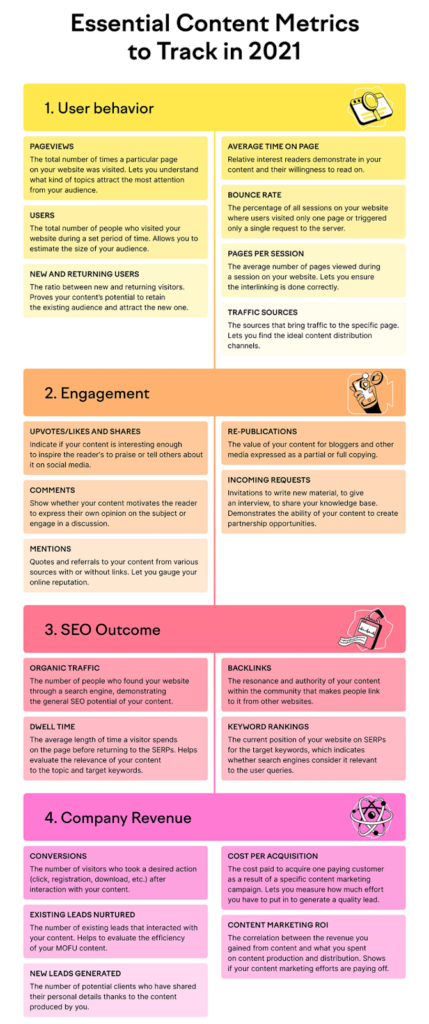How does an integrated content marketing strategy work? To put things simply, this type of marketing strategy uses a variety of platforms to get the message of your brand across to potential buyers. This includes methods such as leveraging social media platforms, TV, radio, billboards, and more.
A recent survey by the content marketing institute showed that 88 percent of businesses owe their increased brand awareness to an effective content marketing strategy. However, reports show that up to 63% of brands don’t have a set strategy for content marketing. And a similar 64% want to learn how to build one.
This article will give a rundown of how content marketing works, with a focus on having an integrated content marketing strategy, and then will offer a step-by-step guide to help new businesses create a winning strategy.
Table of Contents
What is an integrated content marketing strategy?
The benefits of an integrated content marketing strategy
Step-by-step guide to create an effective integrated content marketing strategy
The bottom line
What is an integrated content marketing strategy?

Let’s start with content marketing in general. A content marketing strategy is what businesses use to attract and retain consumers on their social media and other platforms. It involves creating and posting valuable digital content to a targeted audience. Brands can use various forms of content for their strategies, including visual, written, and audio content but generally focus on just one at a time.
On the other hand integrated marketing focuses on multiple platforms rather than an individual one. It makes use of the most effective channels of marketing simultaneously in order to reach a wider audience.
While newer businesses may feel they don’t need an integrated content strategy plan, they should know that it’s an effective way to build awareness and trust amongst their target consumers, and to lay the foundation for the “attract and delight” stages the buyer’s journey–meaning it’s definitely worth thinking about even at the early stages of business development.
A famous integrated content strategy example is Coca-Cola’s “Share a Coke” campaign. The soda giant’s strategy allowed customers to add their names, or the names of their friends or loved ones, to coke bottles. This unique plan created a personal touch that drew customers in, and allowed them to interact with the brand in a new way and share their creations on different social media platforms.
The benefits of an integrated content marketing strategy
Below are the benefits brands can enjoy from creating an effective integrated content marketing strategy.
High-quality content can help build brand awareness
Although there are many ways to build brand awareness, an integrated content marketing strategy can spread awareness in a novel and engaging way. Good content planning and marketing strategies make businesses trend and appear whenever prospective customers search for related products or services. In other words, these strategies can help brands build awareness through the content itself, lowering the expenses needed for outbound marketing.
An integrated content marketing strategy is cost-effective
As mentioned above, integrated content marketing is cost-effective and provides an easy way for brands to generate organic traffic and reduce the budget for paid ads and outbound marketing. Most costs incurred are for hiring freelance writers and editors, which is typically more affordable than paid advertising.
Attract and retain loyal customers
Brands that want to build good brand/customer relationships can use integrated content marketing to keep consumers engaged by hosting question and answer sessions or posting engaging content. This creates value for an audience and can convert them into loyal customers from the very first step.
Great content can make brands market leaders
Building on the importance of value, excellent and valuable online integrated content marketing gives a brand more authority. The more online authority a brand has, the more chances it has to become a market leader.
Excellent content also grants a brand more credibility, especially when the given information is not just attractive but also reliable. Brands should focus on content that solves pain points so customers can turn to them for information and recommendations.
Also, businesses should consider creating evocative and personal stories that help the content they produce to resonate with their customers’ experiences.
Step-by-step guide to create an effective integrated content marketing strategy
When companies develop an effective integrated content marketing strategy, they see higher conversion rates across their funnel and with the use of social media channels they are able to save on their overall marketing costs. So, developing excellent integrated content marketing ideas and strategies is essential if brands want to stay competitive.
Here’s how brands can create strategies that give them an edge over the competition and some useful marketing content integration tools that are good to have at your disposal.
Set up KPIs, goals, and objectives
Every integrated content marketing strategy must have business goals attached to them. And goals have to be measurable and specific.
Brands can add various metrics to their KPIs, including SEO, sales, social media, revenue, traffic, and email marketing. Most importantly, brands should use the SMART (Specific, Measurable, Attainable, Relevant, and Time-bound) approach to goal setting, which offers an effective goal-setting framework.
Here are some examples of goals brands can set and add to their KPIs:
- Get a specific number of new email subscribers this month.
- Increase site traffic and onsite content engagement by 20% in 90 days.
- Increase search ranking on significant search engine results within 60 days.
- Increase the number of shares, comments, and mentions by 50% in 30 days.
- Generate a particular revenue within the month, quarter, or year.
KPIs can also help businesses watch their spending patterns on multiple strategies.
Identify target audience
In order to maximize the impact of content marketing, brands need to create a strategy plan and identify their target audience. The target audience determines the kind of content a brand will create.
Here are two things that are essential to have in an integrated content strategy plan that will help brands identify their target audience:
Get demographic data and know buyer’s persona
First in terms of content marketing basics are demographics. Brands must gather the demographic information of all social media followers, website visitors, and email subscribers. Luckily, it’s easy to do this with social media, web, and email subscriber analytics.
The focus of the demographic data should be age, gender, income, and education. It’s also possible to get insights into the target audience’s fundamental interests. Brands can go deeper by considering in-depth information such as pain points, buying behavior, demographics, challenges, and their current information sources.
Gather customer feedback
Demographics can’t give a brand everything they need about their target audience. Brands can take things further by gathering feedback from their existing customers which will help boost the integrated content marketing strategy. That way, they can know:
- What they think about the type of content the brand creates.
- What they need the most.
- And how the content can offer solutions to their problems.
These insights are central for brands to understand what requires their focus and the kind of strategies they need to reach potential customers.
Additionally, there are many ways brands can gather consumer feedback, including NPS surveys, instant notifications, smart survey fields, real-time polls, or interactive survey reports.
Assess present position
Determining where a brand stands in the market is a great way to know its chances of competing. Brands can use content auditing to access their current position and develop better strategies to move higher up the chain. For a great audit, brands need to log all the content they’ve uploaded and make assessments to fish out those with poor reception.
Here’s how to use content auditing in more detail:
How to log content
Tools like Streaming Frog are great for logging all site and blog content. It’s a URL crawler that can source all related URLs, find duplicates, generate sitemaps, and inspect page descriptions and titles. It’s also possible to check out the competition’s content with this tool.
Examine the content’s effectiveness
There are some specific metrics brands must look for when examining a content’s effectiveness. These metrics include:
- The number of inbound content marketing backlinks clicked by readers.
- The content’s share rate.
- And the content’s search engine ranking and its associated keywords.
SEMRush is a great tool that’ll provide brands with everything they need to find out which content is doing well, and to identify the content that needs updates or elimination.
Discover content gaps
Content gap analysis can help brands discover areas other similar content may not have explored. It could be unanswered questions or content with good rankings that needs small tweaks or some updating to be more relevant.
Ahrefs is excellent for brands to carry out a content gap analysis. With this tool, brands can use different keywords to explore their unique content.
Ascertain the best content channels
At this point, brands should have an idea of where they can find their target audience. But, to prevent errors, retailers can check their analytics data to see where consumers share their content the most.
Buzzsumo is one fantastic marketing tool brands can use for this purpose. It’s a powerful tool that can help businesses get all the necessary analytic data, such as engagements, brand mentions, and backlinks to find the best channel.
Recognize and assign resources
Resource allocation is one of the most crucial parts of a content strategy. Brands must ensure they have everything they need to implement their integrated content marketing strategy before starting with their plans. Otherwise, they may fail to see their plans through successfully.
In order to be well prepared to operationalize their strategy, brands can consider:
- Who will be in charge of content production and maintenance?
- What human, physical, or digital resources are needed for content creation?
- What will be the brand’s publishing schedule?
Design a content calendar
Content calendars help brands set the content topics they want to publish and when. It’s also a way of ensuring brands keep an active posting streak.
It’s essential for brands to have a plan so they can schedule all content and keep readers engaged. For instance, the average business can use Google calendar to set due dates and reminders. It‘s great for brands that don’t push or generate much content.
But, brands with many publishing plans will need more than just regular calendars. Retailers can use tools like Asana or CoSchedule that allow the scheduling of different areas of a brand’s content creation process. Here’s a comprehensive article showing how to design a content calendar.
Start producing content
Brands can use the data from the previous steps to know what kind of content they’re making, but to ensure they’re creating great quality work, they can also:
- Place emphasis on original content to catch the attention of more readers. To achieve this, brands should also invest in quality research.
- Diversifying content on a business blog is important for brands that want to attract a lot of reads and encourage shares. This is because every consumer has different preferences. For instance, a blog can have PDF, video, visual, text, and interactive content to capture their different audiences.
- Repurposing already published posts is another smart way to produce great content consistently. For example, turn long-form articles into shorter series posts, create Twitter snippets from an article, or convert a blog post to a podcast/video.
- Leverage user-generated content by adding it to the narrative of the brand’s content across all platforms. Businesses can use customer reviews, videos, photos, and comments to add more authenticity.
Distribute content and marketing
Distribution and marketing are key factors that determine content results. There are several ways brands can distribute and market their content. These channels for content promotion include:
- Set a schedule to automatically or manually share content to social media.
- Also, distribute content to subscribers through emails.
- Leverage influencer marketing to spread the word and get an extended reach.
Measure results
A solid integrated content marketing campaign framework is a must-have for brands. So, to achieve this, they should use the four essential content marketing metrics (below), and they should rely on an effective analytics tool to measure their KPIs.
Below is an illustration showing the four key content marketing groups of metrics.

The bottom line
Having a solid integrated content marketing strategy has many benefits, including increasing brand recognition and maintaining a loyal customer base. But these results may not happen immediately so brands need to plan, set goats, and properly allocate resources to create and operationalize an effective strategy.
This can be a challenge, but this article has outlined key steps brands can use to ensure success as well as some integrated content marketing strategy tips that will help drive business growth.



